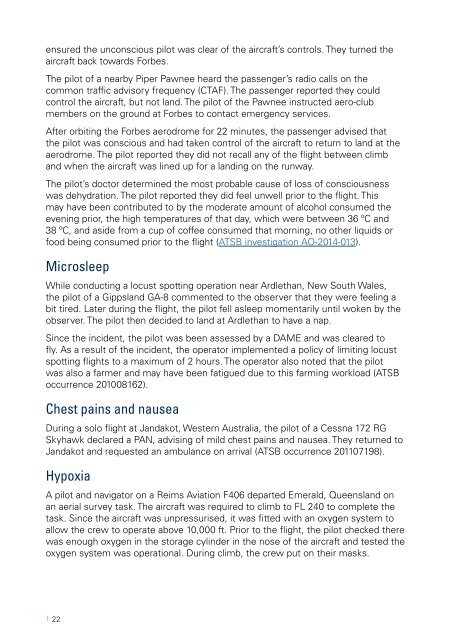Pilot incapacitation occurrences 2010–2014
8rKXy6YKY
8rKXy6YKY
You also want an ePaper? Increase the reach of your titles
YUMPU automatically turns print PDFs into web optimized ePapers that Google loves.
ensured the unconscious pilot was clear of the aircraft’s controls. They turned the<br />
aircraft back towards Forbes.<br />
The pilot of a nearby Piper Pawnee heard the passenger’s radio calls on the<br />
common traffic advisory frequency (CTAF). The passenger reported they could<br />
control the aircraft, but not land. The pilot of the Pawnee instructed aero-club<br />
members on the ground at Forbes to contact emergency services.<br />
After orbiting the Forbes aerodrome for 22 minutes, the passenger advised that<br />
the pilot was conscious and had taken control of the aircraft to return to land at the<br />
aerodrome. The pilot reported they did not recall any of the flight between climb<br />
and when the aircraft was lined up for a landing on the runway.<br />
The pilot’s doctor determined the most probable cause of loss of consciousness<br />
was dehydration. The pilot reported they did feel unwell prior to the flight. This<br />
may have been contributed to by the moderate amount of alcohol consumed the<br />
evening prior, the high temperatures of that day, which were between 36 oC and<br />
38 oC, and aside from a cup of coffee consumed that morning, no other liquids or<br />
food being consumed prior to the flight (ATSB investigation AO-2014-013).<br />
Microsleep<br />
While conducting a locust spotting operation near Ardlethan, New South Wales,<br />
the pilot of a Gippsland GA-8 commented to the observer that they were feeling a<br />
bit tired. Later during the flight, the pilot fell asleep momentarily until woken by the<br />
observer. The pilot then decided to land at Ardlethan to have a nap.<br />
Since the incident, the pilot was been assessed by a DAME and was cleared to<br />
fly. As a result of the incident, the operator implemented a policy of limiting locust<br />
spotting flights to a maximum of 2 hours. The operator also noted that the pilot<br />
was also a farmer and may have been fatigued due to this farming workload (ATSB<br />
occurrence 201008162).<br />
Chest pains and nausea<br />
During a solo flight at Jandakot, Western Australia, the pilot of a Cessna 172 RG<br />
Skyhawk declared a PAN, advising of mild chest pains and nausea. They returned to<br />
Jandakot and requested an ambulance on arrival (ATSB occurrence 201107198).<br />
Hypoxia<br />
A pilot and navigator on a Reims Aviation F406 departed Emerald, Queensland on<br />
an aerial survey task. The aircraft was required to climb to FL 240 to complete the<br />
task. Since the aircraft was unpressurised, it was fitted with an oxygen system to<br />
allow the crew to operate above 10,000 ft. Prior to the flight, the pilot checked there<br />
was enough oxygen in the storage cylinder in the nose of the aircraft and tested the<br />
oxygen system was operational. During climb, the crew put on their masks.<br />
› 22


